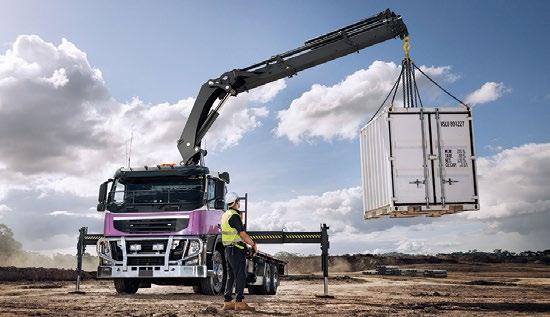
5 minute read
It was only a matter of time
Time Manufacturing’s acquisition of German truck mount and spider lift manufacturer Ruthmann last month may have raised a few eyebrows - that Ruthmann didn’t acquire Time/Versalift International if nothing else - but perhaps more surprising was that it took as long as it did. Both companies have been developing a distribution partnership for the past 10 years or so, helped along by the fact that they have minimal product line overlap. In hindsight, the increasingly close working relationship and future growth potential made their coming together an obvious one.
Time on the acquisition trail
Time/Versalift’s long term owners, Ireland’s O’Flaherty Holdings, sold the business to private equity firm the Sterling group in 2017, and many wondered why Ruthmann had not been given ‘first refusal’ - perhaps it was? Since the Sterling group took over, Time has been on the acquisition trail, adding eight companies within the US. This included underbridge platform manufacturer Aspen Aerials and fiberglass truck body manufacturer BrandFX as well as a number of distributors covering the South East and Midwest regions. Ruthmann is not only the group’s first acquisition outside of the US but it is also the largest. With annual revenues of €170 million the combined businesses will likely generate revenues in the region of €375 million.

One of the first Ruthmann Steiger truck mounted platforms
Ruthmann was established in 1901 when founder, Anton Ruthmann, formed a bicycle and sewing machine shop. It wasn’t until the second generation took over in the 1940s that the company pivoted to making carts, trolleys and what would become the first Cargoloader hydraulic truck bed in 1949. The company went on to build its first Steiger truck mounted platform in 1954, adding a telescopic boom in 1956, with many of those early units mounted on Volkswagen Kombi chassis.
The company continued to expand its range and working heights, before in 2001 it introduced the world’s largest truck mounted platform in the form of the 100 metre TTS1000. The cost of designing and building such a large machine, at the same time as an economic slowdown exasperated by fierce Italian competition in the volume market for smaller models, caused serious financial difficulties and in 2003 the business was acquired by Heinrich Winkelmann and Heinz-Jürgen Buss.

The pair wasted no time in implementing a number of leaner construction and production procedures to help turn the company around and between 2008 and 2010 lifted revenues to €50 million, in spite of the global economic crisis. Following this period of growth and success, the management of the company was handed over to then general service manager, Rolf Kulawik. The following year - 2011 - Ruthmann acquired Versalift’s German sales operation, Time Deutschland Versalift, along with the German distribution rights for Versalift platforms. This move kick started a partnership that has continued to grow slowly and steadily ever since.
A fruitful relationship
This relationship has seen Versalift distribute Ruthmann products in a number of countries, including North America, Spain, Portugal as well as the Nordic and Benelux regions. Ruthmann on the other hand distributes Versalift in Germany, Austria and Switzerland, while both companies also share a number of dealerships. A large contributing factor behind the success of this arrangement has been the minimal conflict between the two product ranges.

The acquisition of Ruthmann will provide Time with its highly respected, highly engineered range of truck mounted lifts with working heights from 17 to 90 metres, along with its more competitively priced Italian built Ecoline range mounted on 3.5 tonne chassis. Its Ecoline range is a result of Ruthmann’s acquisition of Bluelift in 2016, which also gave it a line of high quality spider lifts and some talented engineers.
In Europe, the only conflict between the two companies’ product lines are, perhaps, a handful of models mounted on 3.5 and 7.5 tonne chassis with working heights up to 25 metres. In general, Versalift models are geared towards the utility and telecommunications markets, while the Ruthmann models are more targeted at the general and rental market. On paper, there is marginally more overlap in the US although around 70 percent of Time’s truck mounts in the US are fully insulated and designed for working near live powerlines, a sector that Ruthmann has only recently flirted with.

Versalift offers a handful of ‘spider lifts’ but these have mostly involved mounting its truck mounted superstructures on heavy duty tracked chassis. Ruthmann’s range of Bluelift spider lifts, which offer working heights of 10.8 to 31 metres, will likely appeal to a wider audience. It will be interesting to see whether the extra sales and support from Time in the US will help Ruthmann, and its wholly owned distributor ReachMaster, grab a share of the rapidly growing spider lift market, currently dominated by Platform Basket and CMC, and also contested by Teupen and JLG/Hinowa.
Time also gains Ruthmann’s facilities in Germany and Italy, joining its Versalift plants in the USA, Denmark, the UK and France. It also gains Ruthmann’s 11 service locations in Germany, Austria, Italy and Switzerland, plus ReachMaster in Texas.

Time focuses its efforts on the utility, telecom, infrastructure, and forestry sectors
A perfect match?
If Time’s past acquisitions are anything to go by, Ruthmann and its management team will continue to operate as a standalone business under the ‘A Time Manufacturing Company’ banner. The combination of the two vehicle mounted product lines presents an impressive range of truck and van mounted lifts with working heights from 8.9 to 90 metres. Traditionally, Time has focused its product development efforts on products for the utility, telecommunications, infrastructure, and forestry sectors with great success, but the addition of Ruthmann means that the group almost has something for everyone. Either way, it will be interesting to see how the post-acquisition period pans out, and how the two teams communicate and integrate with each other. It has great potential to for both brands, but time will tell.











